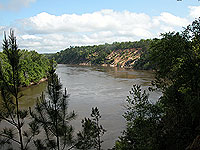Water: Types
Fresh water, brackish water, salt water
 Alum Bluff in Liberty County. Photo courtesy Florida Geological Survey. |
The diversity is mind-boggling, and it's one of the reasons the region has such an incredible number of plant and animal species.
The difference in salt content between fresh, brackish, and salt water doesn't sound like much. It's measured in parts per thousand, and the difference between fresh water and brackish water is especially fine.
| Type of water | Salt content (parts per thousand) |
| Fresh | Less than 0.5 |
| Brackish (estuarine) | 0.5 to 30 |
| Salt (coastal ocean) | 30-37 |
Fresh, brackish, and salt waters sustain different collections of plant and animal species, many of which can live only in a certain narrow range of salt concentration. Oysters, for example, cannot live in fresh water, but in salt water, they fall prey to predators and disease. Hence, oysters thrive in the brackish estuarine waters of Apalachicola Bay. Salinity in our fertile estuaries is balanced between fresh water coming in from rivers and salt water carried in from the Gulf of Mexico.
Why are estuaries so fertile? Because the rivers carry tiny pieces of ground-up leaves from the floodplain forests lining the riverbanks south to the coastal marshes and bays, where they are eaten by fish and crabs. These tiny bits of nourishment, which ecologists call "detritus," form the basis of the food chain in brackish waters. If the rivers were to stop flowing, the fertility of the estuaries would decline and, ultimately, life in the bays would die as well.
Note: The content of the website has not been updated since 2005. The site remains online for it's value as legacy content and is unlikely to be updated.